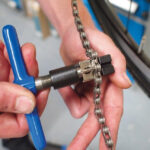Are you curious if you can transform your regular bike into an electric one? Absolutely, you can make almost any bike electric with the help of e-bike conversion kits. At usabikers.net, we’re dedicated to providing you with the knowledge and resources you need to explore the world of electric bikes and biker culture. Discover how these kits offer an affordable and sustainable way to upgrade your ride and join the electric revolution. With the rising popularity of e-bikes, these kits provide a cost-effective solution for upgrading your current bike and experiencing the benefits of electric assistance. Dive into our comprehensive guide to find the best e-bike conversion kit for your needs and explore the ease of installation, compatibility, and performance enhancements.
1. Understanding E-Bike Conversion Kits
What exactly are e-bike conversion kits and how do they work? E-bike conversion kits are packages that allow you to convert a standard bicycle into an electric bike, providing an electric boost to your ride without the cost of purchasing a brand-new e-bike. These kits generally include a motor, battery, controller, and associated hardware, enabling you to electrify your existing bicycle frame. You can transform your trusty steed into an eco-friendly machine. According to a report by the Electric Bike Association, the conversion kit market has seen a steady increase in popularity, driven by the desire for cost-effective and sustainable transportation solutions.
1.1 What are the main components of an e-bike conversion kit?
The primary components include a motor, battery, controller, display, and wiring harness. The motor is typically located in the hub of the front or rear wheel or as a mid-drive unit mounted near the pedals. The battery provides the necessary power for the motor. The controller regulates the power output and speed. A display unit shows vital information like battery level and speed. A wiring harness connects all the components.
1.2 What are the different types of e-bike conversion kits?
There are primarily three types of e-bike conversion kits: hub motor kits, mid-drive motor kits, and friction drive kits. Each type offers unique advantages and caters to different riding preferences.
-
Hub Motor Kits: These kits replace either the front or rear wheel of your bike with a motorized wheel. Front hub motors are easier to install. Rear hub motors offer better traction.
-
Mid-Drive Motor Kits: Mid-drive motors are mounted in the center of the bike, replacing the bottom bracket. They provide a more balanced weight distribution and utilize the bike’s gears for efficient power output.
-
Friction Drive Kits: These kits use a motor that presses against the tire to propel the bike. They are less common due to potential tire wear and reduced efficiency.
2. Key Considerations Before Converting Your Bike
Before diving into the world of e-bike conversions, what essential factors should you consider to ensure a successful and satisfying transformation? Consider compatibility, motor power, battery capacity, and local regulations. These factors will influence your choice of conversion kit and ensure that your converted e-bike meets your needs and complies with legal requirements. According to research from the American Motorcyclist Association (AMA), in June 2024, understanding these key considerations is crucial for a safe and enjoyable e-biking experience.
2.1 What are the compatibility factors to consider?
Frame type, wheel size, brake type, and dropout width are crucial compatibility factors. Ensure that the conversion kit is compatible with your bike’s frame material (alloy or steel), wheel size (26″, 27.5″, 29″, or 700c), and brake type (disc or rim brakes). Measure the dropout width (the space where the wheel attaches to the frame) to ensure the motor fits correctly.
2.2 What motor power and battery capacity do I need?
Motor power and battery capacity depend on your riding style, terrain, and desired range. For flat urban commuting, a 250W to 350W motor with a 36V battery may suffice. For hilly terrain or longer distances, consider a 500W to 750W motor with a 48V battery. Battery capacity is measured in amp-hours (Ah) or watt-hours (Wh). Higher Ah or Wh values indicate longer range.
2.3 How do local e-bike regulations affect my conversion?
Local e-bike regulations vary by state and city. Check the laws regarding motor power limits, speed limits, and throttle restrictions. In the United States, many states classify e-bikes into three classes:
- Class 1: Pedal-assist only, with a motor that stops assisting at 20 mph.
- Class 2: Throttle-assisted, with a motor that stops assisting at 20 mph.
- Class 3: Pedal-assist only, with a motor that stops assisting at 28 mph.
Ensure your converted e-bike complies with these regulations to avoid fines or legal issues.
3. Top E-Bike Conversion Kits on the Market
What are some of the best e-bike conversion kits currently available that balance performance, ease of installation, and reliability? Let’s explore several top-rated e-bike conversion kits on the market, highlighting their key features, pros, and cons. These kits represent a range of options suitable for different bikes and riding styles. Choosing the right kit can significantly enhance your e-biking experience, providing a reliable and enjoyable ride.
3.1 Swytch Bike Air
The Swytch Bike Air eBike Conversion Kit is known for its lightweight design and ease of fitting. It is an excellent choice for those seeking a simple and efficient conversion.
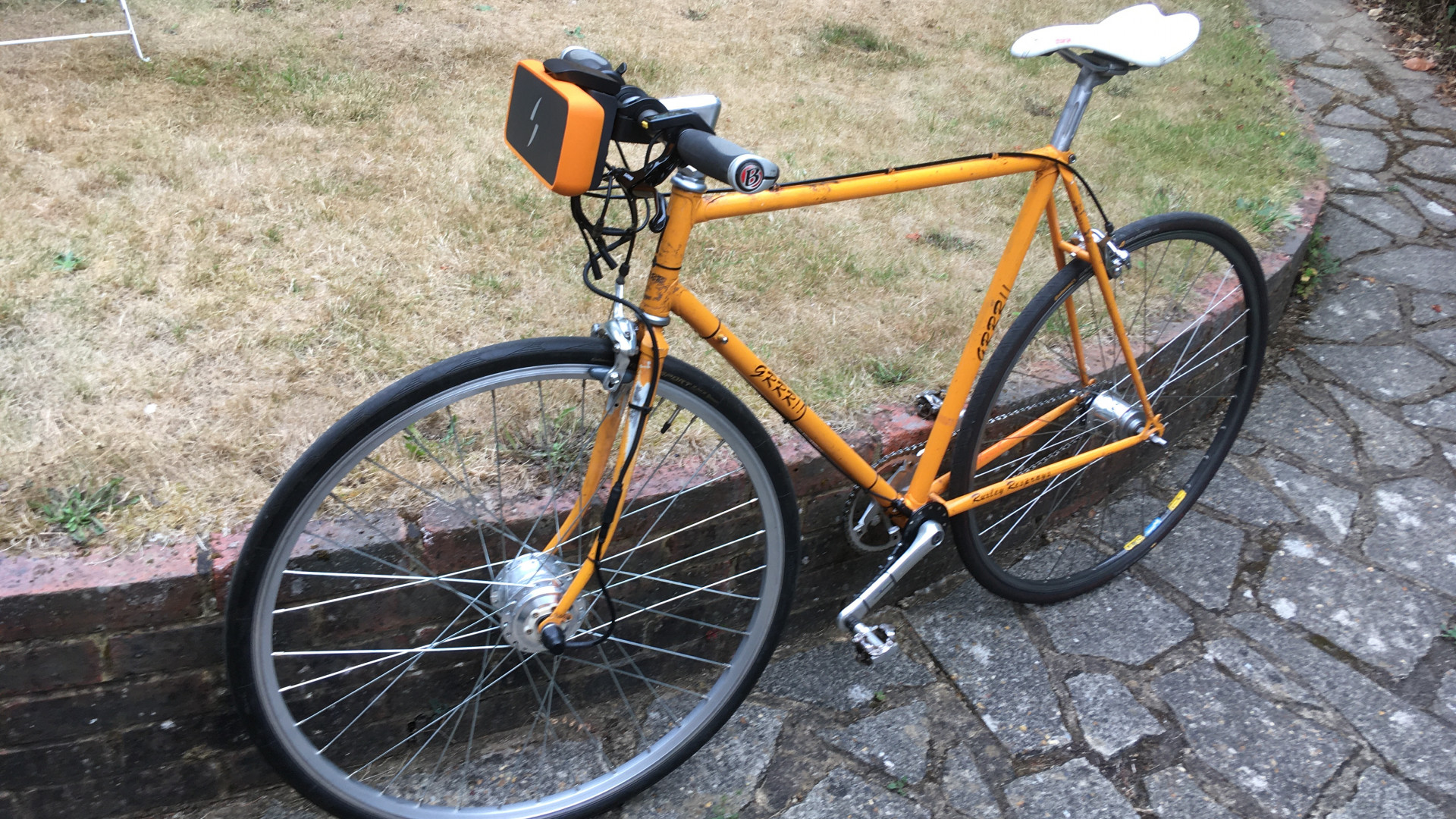 Swytch Max Air Kit ebike conversion kit fitted on a bike
Swytch Max Air Kit ebike conversion kit fitted on a bike
Key Features:
- Compact and lightweight design
- Easy to install
- Available with Air (98Wh, 15km range) or Max (180Wh, 30km range) battery
- 40Nm torque
- Compatible with rim and disc brakes (100mm quick release dropouts)
- Custom-built wheel sizes
Pros:
- Very simple to set up
- Sleek design
- Lightweight
Cons:
- Shorter range
- Often sold out
3.2 TongSheng TSDZ2 Mid Drive Motor
The TongSheng TSDZ2 Mid Drive Motor is a popular choice for those seeking a mid-drive conversion kit. It offers a balanced weight distribution and efficient power delivery.
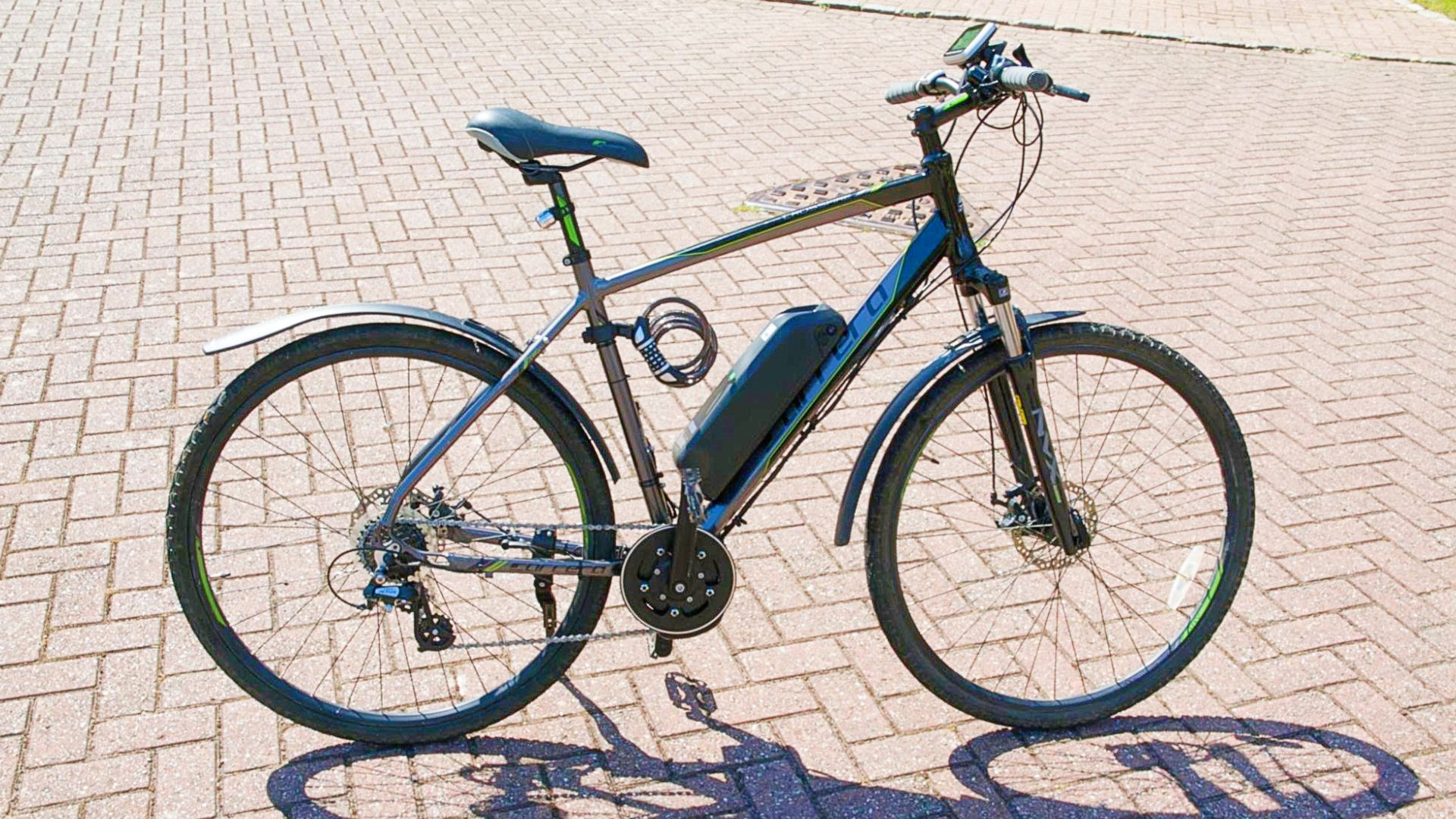 Tongsheng TSDZ2 Mid Drive e-bike conversion kit fitted on a bike
Tongsheng TSDZ2 Mid Drive e-bike conversion kit fitted on a bike
Key Features:
- Mid-drive motor for balanced weight distribution
- 80Nm torque
- Compatible with alloy bikes and 68-73mm bottom brackets
- Battery sold separately
Pros:
- Lightweight for the power output
- Compatible with a wide range of bike designs
- Better ground clearance
Cons:
- Battery must be bought separately
3.3 Voilamart 48V Rear Wheel Kit
The Voilamart 48V Rear Wheel Kit is an affordable option for converting your bike to an e-bike. It provides plenty of power and is suitable for those on a budget.
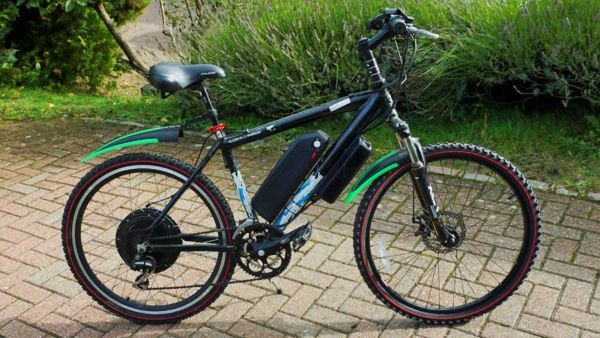 Image shows rear wheel ebike kit fitted to a bike
Image shows rear wheel ebike kit fitted to a bike
Key Features:
- Inexpensive rear wheel conversion
- 45Nm torque
- Battery sold separately
- Clear and easy-to-read display screen
- 26″ wheel size
Pros:
- Affordable
- Plenty of power
- Easy-to-read display
Cons:
- Some components feel cheap
- Battery not included
- Requires removal of crank to fit pedal sensor
- Not waterproof
3.4 Skarper DiskDrive System
The Skarper DiskDrive System stands out for its ease of setup and compatibility. It’s a great option for those who value simplicity and versatility.
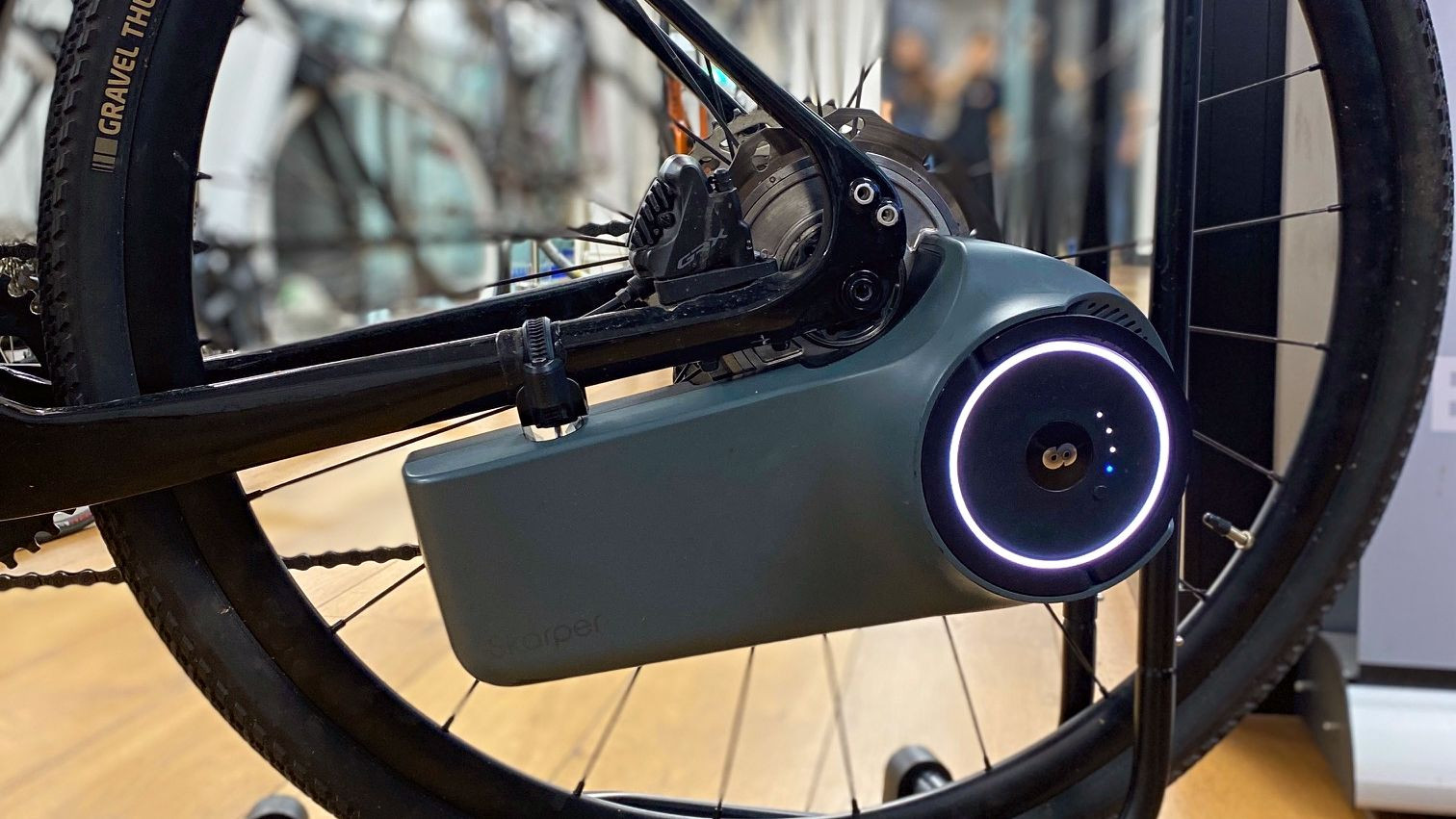 Skarper ebike conversion kit mounted to the rear triangle of a bicycle
Skarper ebike conversion kit mounted to the rear triangle of a bicycle
Key Features:
- Compatible with any bike with a disc brake
- Claimed 50km range in Eco mode, 30km in Turbo mode
- 45Nm torque
- Super simple to fit
Pros:
- Cheaper than a complete rear hub Mahle ebike
- Reasonable weight
- Very strong in turbo mode
- Excellent compatibility
Cons:
- More expensive than most ebike conversion kits
- Unproven durability
- Eco mode could be stronger
3.5 Bafang Mid Motor Kit
The Bafang Mid Motor Kit is designed for off-road enthusiasts. It delivers high torque and is compatible with a wide range of bikes.
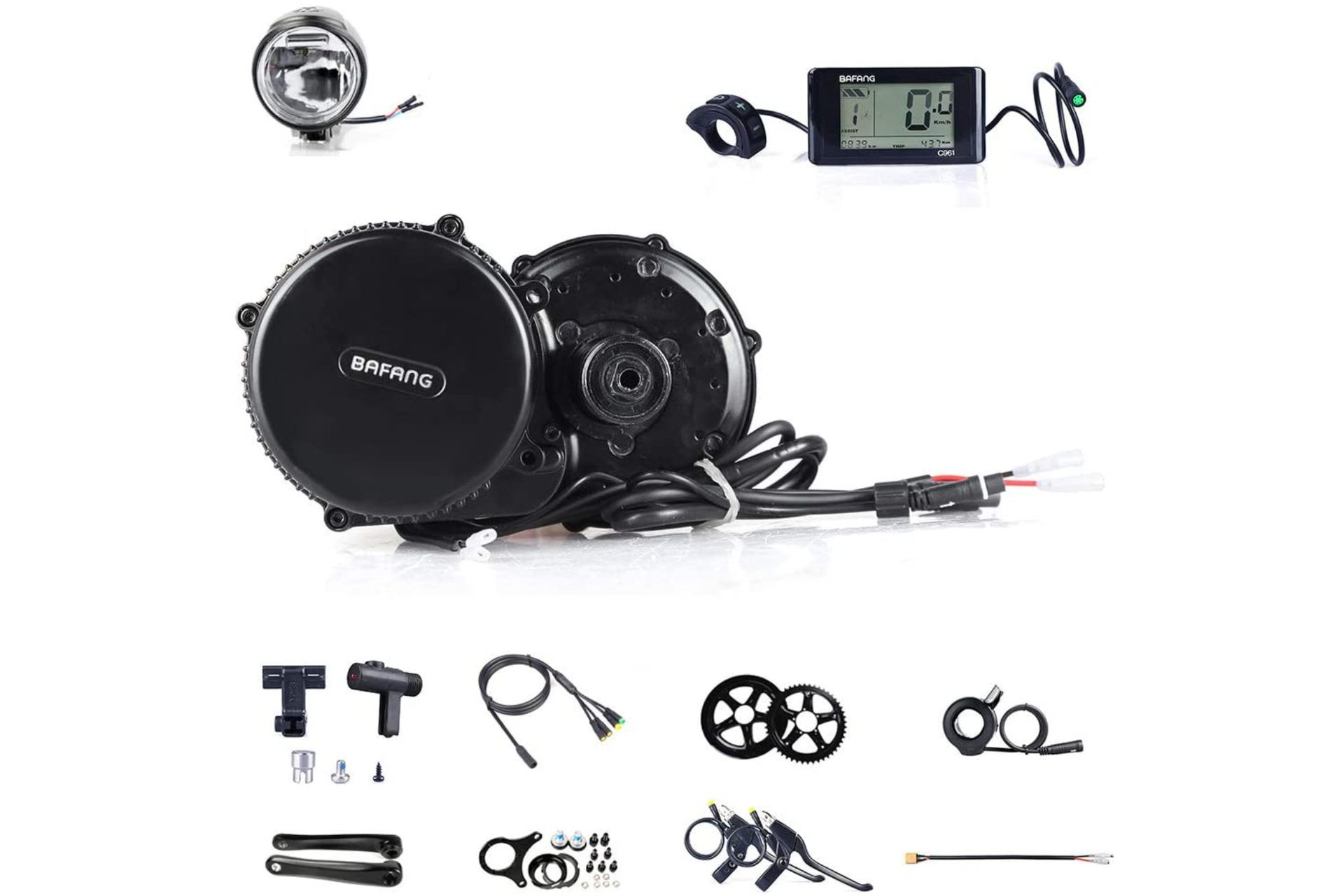 Bafang mid drive which is one of the best electric bike conversion kits
Bafang mid drive which is one of the best electric bike conversion kits
Key Features:
- Mid-motor drive system
- 80Nm torque
- Compatible with alloy bikes and 68-73mm bottom brackets
- Battery sold separately
Pros:
- Capable off-road
- Keep your current wheels
- High torque
Cons:
- Low-slung motor reduces ground clearance
- Battery sold separately
3.6 Bafang Front Hub Motor Kit
The Bafang Front Hub Motor Kit is a budget-friendly option from a reputable brand. It’s easy to set up and provides good value for the price.
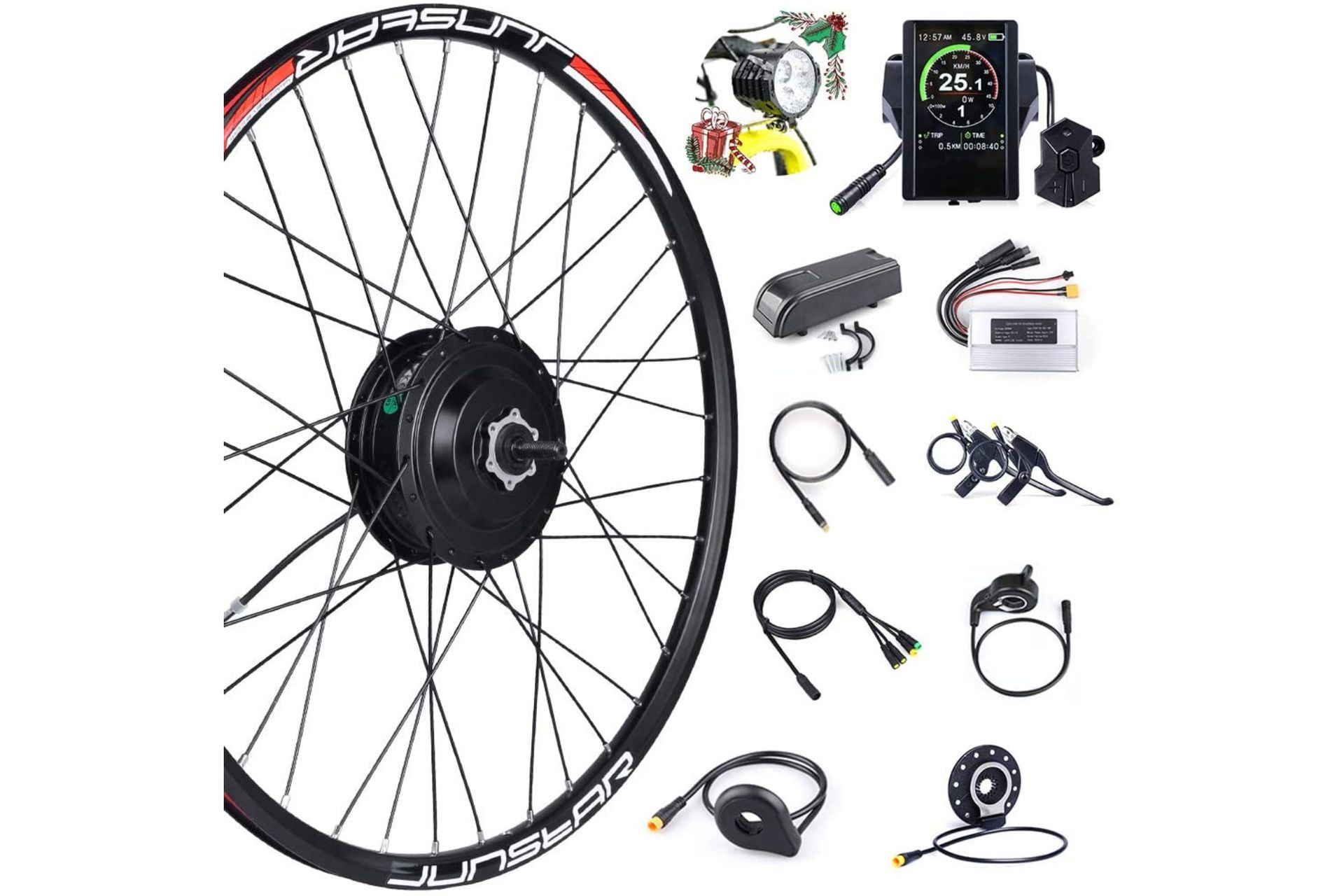 Bafang front hub motor kit which is one of the best electric bike conversion kits
Bafang front hub motor kit which is one of the best electric bike conversion kits
Key Features:
- Front hub motor
- 11.6-17.5Ah battery options (45-68km range)
- 65Nm torque
- Compatible with disc brakes and quick-release axles
- Available in various wheel sizes
Pros:
- Good value
- Less bulky
Cons:
- Instructions could be better
4. Step-by-Step Guide to Converting Your Bike
How do you actually install an e-bike conversion kit? Here’s a general step-by-step guide to installing an e-bike conversion kit. While the exact steps may vary depending on the specific kit, these instructions will provide a solid foundation for your conversion project. Following these steps carefully will help ensure a safe and functional e-bike conversion. According to the Motorcycle Safety Foundation (MSF), in August 2024, proper installation is crucial for the safety and performance of your e-bike.
4.1 What tools and equipment are needed for the conversion?
Gather essential tools such as a wrench set, screwdrivers, wire cutters, electrical tape, and a multimeter. Additionally, consider having zip ties, a bike stand, and safety glasses for a smooth and safe installation process.
4.2 How to install a front hub motor kit
- Remove the Front Wheel: Detach the existing front wheel from your bike.
- Install the Tire and Tube: Transfer the tire and tube from the old wheel to the new motorized wheel.
- Mount the Motorized Wheel: Install the motorized wheel onto your bike’s front fork.
- Attach the Controller: Mount the controller to the handlebars or frame.
- Connect the Wiring: Connect the motor, battery, and controller using the provided wiring harness.
- Install the Pedal Assist Sensor (PAS): Attach the PAS to the crank arm and frame to enable pedal-assist functionality.
- Mount the Battery: Secure the battery to the frame using the provided mounting hardware.
- Test the System: Turn on the system and test the motor, throttle, and pedal assist functions.
4.3 How to install a mid-drive motor kit
- Remove the Crankset: Detach the existing crankset from your bike’s bottom bracket.
- Install the Mid-Drive Motor: Mount the mid-drive motor onto the bottom bracket.
- Connect the Wiring: Connect the motor, battery, and controller using the provided wiring harness.
- Install the Pedal Assist Sensor (PAS): Attach the PAS to the crank arm and frame to enable pedal-assist functionality.
- Mount the Battery: Secure the battery to the frame using the provided mounting hardware.
- Test the System: Turn on the system and test the motor, throttle, and pedal assist functions.
4.4 How to ensure proper wiring and connections
Ensure all wiring connections are secure and properly insulated to prevent short circuits or damage. Use electrical tape or heat shrink tubing to protect exposed wires. Double-check all connections before testing the system.
5. Maintaining Your Converted E-Bike
Once your e-bike conversion is complete, what maintenance practices are essential to keep your electric ride in top condition and ensure longevity? Regular maintenance is vital for keeping your converted e-bike running smoothly and safely. By following these maintenance tips, you can extend the life of your e-bike and enjoy a reliable and enjoyable riding experience. According to a study by the Bicycle Product Suppliers Association (BPSA), in September 2024, proper maintenance can significantly increase the lifespan of e-bike components.
5.1 What are the key maintenance tasks for e-bikes?
Regularly check and maintain the battery, motor, brakes, tires, and chain. Clean and lubricate the chain, inspect brake pads for wear, and ensure tires are properly inflated.
5.2 How to properly care for the battery
Store the battery in a cool, dry place and avoid extreme temperatures. Charge the battery regularly, even when not in use, to maintain its health. Avoid fully discharging the battery, as this can reduce its lifespan.
5.3 How to troubleshoot common issues
Consult the conversion kit’s manual for troubleshooting tips. Common issues include motor malfunctions, battery problems, and wiring issues. If you’re unable to resolve the issue yourself, seek assistance from a qualified e-bike technician.
6. The Benefits of Converting Your Bike
Why should you consider converting your bike to an e-bike? There are numerous benefits to converting your bike to an e-bike, including cost savings, environmental benefits, and improved fitness. Converting your bike offers a practical and sustainable way to enjoy the advantages of electric-powered cycling. Embracing e-biking can transform your daily commute, recreational rides, and overall lifestyle.
6.1 What are the cost savings compared to buying a new e-bike?
Converting your existing bike is typically more affordable than purchasing a new e-bike. Conversion kits range from a few hundred to over a thousand dollars, while new e-bikes can cost several thousand dollars.
6.2 What are the environmental benefits of e-bike conversion?
E-bike conversion promotes sustainability by repurposing existing bicycles and reducing the demand for new manufacturing. E-bikes also produce zero emissions, making them an environmentally friendly transportation option.
6.3 How can e-bikes improve fitness and health?
E-bikes provide pedal assistance, allowing riders to tackle longer distances and steeper hills with less effort. This can encourage more frequent and longer bike rides, leading to improved cardiovascular health, increased muscle strength, and enhanced overall fitness.
7. Exploring the Biker Community and Culture
How does e-biking fit into the broader biker community and culture, particularly in the United States? E-biking is increasingly embraced within the biker community, offering new avenues for exploration, adventure, and camaraderie. Exploring the biker culture can enrich your e-biking experience. E-bikes are enabling riders of all ages and fitness levels to participate in group rides and events, fostering a more inclusive and diverse community.
7.1 What are some popular biker destinations in the USA?
The USA offers numerous scenic destinations for bikers, including:
- Sturgis, South Dakota: Known for the annual Sturgis Motorcycle Rally.
- Tail of the Dragon, North Carolina/Tennessee: Famous for its 318 curves in 11 miles.
- Pacific Coast Highway, California: Offers stunning coastal views.
- Blue Ridge Parkway, North Carolina/Virginia: A scenic route through the Appalachian Mountains.
7.2 How to connect with local biker groups and clubs
Connect with local biker groups and clubs through online forums, social media, and local motorcycle shops. Attending biker events and rallies is a great way to meet like-minded individuals and share your passion for riding.
7.3 How does usabikers.net support the biker community?
Usabikers.net provides a platform for bikers to connect, share information, and explore the latest trends in the industry. We offer articles, reviews, and resources to support the biker community and promote safe and enjoyable riding experiences.
8. Safety Tips for Riding Your Converted E-Bike
What safety precautions should you take when riding your converted e-bike to ensure a safe and enjoyable experience? Safety should be a top priority when riding your converted e-bike. By following these safety tips, you can minimize risks and enjoy a secure and confident ride. Always prioritize safety to protect yourself and others on the road.
8.1 What safety gear is essential for e-bike riders?
Wear a properly fitted helmet, reflective clothing, and eye protection. Consider using gloves and sturdy footwear to protect your hands and feet.
8.2 How to ride safely in different weather conditions
Adjust your riding style to suit the weather conditions. In wet weather, reduce your speed and increase your braking distance. In windy conditions, be aware of crosswinds and maintain a steady grip on the handlebars.
8.3 What are the rules of the road for e-bikes?
Follow all traffic laws and regulations. Use hand signals to indicate turns and lane changes. Be aware of pedestrians and other vehicles, and always yield the right of way when necessary.
9. Legal Aspects and Regulations
What legal considerations and regulations should you be aware of when converting and riding an e-bike? Understanding the legal aspects and regulations surrounding e-bikes is crucial for responsible and compliant riding. Familiarize yourself with local laws to ensure you’re operating your e-bike legally and safely. Staying informed about these regulations will help you avoid potential fines and legal issues.
9.1 What are the federal laws regarding e-bikes in the USA?
Federal law defines low-speed electric bicycles as two- or three-wheeled vehicles with fully operable pedals, a motor of no more than 750 watts, and a maximum assisted speed of 20 mph. These e-bikes are generally regulated like traditional bicycles.
9.2 How do state and local laws vary?
State and local laws vary regarding e-bike classifications, speed limits, and usage restrictions. Some states require e-bike riders to be a certain age, while others restrict e-bike usage on certain trails or paths.
9.3 How to ensure your converted e-bike is compliant
Ensure your converted e-bike complies with federal, state, and local regulations by adhering to motor power limits, speed limits, and other restrictions. Check with your local Department of Motor Vehicles (DMV) or transportation agency for specific requirements.
10. Future Trends in E-Bike Conversion Technology
What emerging trends and technological advancements can we expect to see in the future of e-bike conversion kits? The future of e-bike conversion technology is poised for exciting advancements, driven by innovation and increasing demand. Staying abreast of these trends will help you make informed decisions about your e-biking journey and anticipate future possibilities. Expect to see more integration, efficiency, and user-friendly features in upcoming e-bike conversion products.
10.1 What are the latest innovations in motor technology?
Recent innovations include more efficient and lightweight motors, integrated torque sensors, and improved heat management systems. These advancements enhance performance, extend range, and improve the overall riding experience.
10.2 How are batteries becoming more efficient and compact?
Battery technology is evolving rapidly, with advancements in lithium-ion batteries, solid-state batteries, and wireless charging systems. These innovations result in batteries that are more energy-dense, longer-lasting, and easier to charge.
10.3 What are the potential future developments in e-bike conversion kits?
Future developments may include more integrated and user-friendly kits, smartphone connectivity, and advanced safety features. Expect to see more customizable options and kits tailored to specific bike types and riding styles.
Transforming your regular bike into an electric one is a rewarding endeavor. Whether you’re looking to save money, reduce your carbon footprint, or simply enjoy a more effortless ride, e-bike conversion kits offer a versatile and accessible solution. Remember to consider compatibility, motor power, battery capacity, and local regulations before making your choice. Stay safe on the road, connect with the vibrant biker community, and embrace the future of e-biking.
Ready to start your e-bike adventure? Visit usabikers.net today to explore articles, reviews, and resources that will guide you every step of the way. Join our community of passionate bikers and discover the freedom and excitement of riding an electric bike.
Address: 801 Sturgis Main St, Sturgis, SD 57785, United States
Phone: +1 (605) 347-2000
Website: usabikers.net
FAQ: E-Bike Conversion Kits
1. Can I convert any bike to an e-bike?
Most bikes can be converted, but compatibility depends on frame type, wheel size, and brake type.
2. How much does it cost to convert a bike to an e-bike?
Conversion kits range from a few hundred to over a thousand dollars, depending on the components.
3. Is it cheaper to convert a bike or buy a new e-bike?
Converting is generally cheaper than buying a new e-bike.
4. What are the different types of e-bike conversion kits?
Hub motor kits, mid-drive motor kits, and friction drive kits are the main types.
5. How do I choose the right e-bike conversion kit?
Consider your riding style, terrain, and local regulations to select the appropriate kit.
6. What is the typical range of a converted e-bike?
Range depends on battery capacity and riding conditions, typically ranging from 20 to 50 miles.
7. Are e-bike conversion kits legal?
Yes, as long as they comply with federal, state, and local regulations regarding motor power and speed limits.
8. How difficult is it to install an e-bike conversion kit?
Installation difficulty varies, but most kits come with instructions and can be installed by a competent DIYer.
9. What maintenance is required for a converted e-bike?
Regularly check and maintain the battery, motor, brakes, tires, and chain.
10. How can I find local e-bike resources and support?
Check with local bike shops, e-bike communities, and online forums for resources and support.

